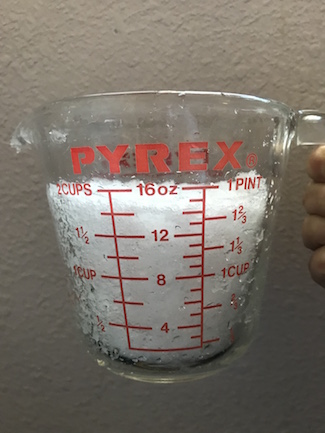 Two cups of snow scooped up from the front yard at the NMSU Agricultural Science Center at Los Lunas on January 3rd melted down to a little over 1/3 cup of water, but this isn’t always true because temperature has a big impact on snow density. Photo credit M. Thompson.
Two cups of snow scooped up from the front yard at the NMSU Agricultural Science Center at Los Lunas on January 3rd melted down to a little over 1/3 cup of water, but this isn’t always true because temperature has a big impact on snow density. Photo credit M. Thompson.
Question: We got 4 inches of snow just before the New Year that’s still melting a week later. I’m glad the established trees and shrubs are getting some water but is it enough to hold off on watering manually this month?
Joe S., Belen, NM
Answer: There’s a rule of thumb that 10 inches of snow equals 1 inch of water, but it really depends on how wet the snow is, and that depends on temperature. Drier snow can be expected at lower temperatures and vice versa. I found some fun calculations and snowmelt discussions online. (Just like snow weight, fun is relative.) “In general, colder temperatures make snow fall less densely and lower the rain-to-snow ratio, resulting in more inches of snow per inch of rain… If 3 inches of rain are expected but the temperature drops suddenly to 5 degrees Fahrenheit, 120 inches of snow will fall” (Richard Graham, www.sciencing.com). That’s compared to 30 inches of snow required to get 3 inches of water when temperatures are close to freezing.
Until this past monsoon, I’d have said we’ll never expect 3 inches of rain on a single day in New Mexico. And I would have been wrong. On August 16, some areas of Doña Ana County got over 2.5 inches of rain. On July 24, more than 3.5 inches of rain was recorded in Santa Fe and Colfax Counties. Dr. Curtis Smith and I drove back down from Raton in that wild rainstorm. And some reported almost 4 inches of rain on August 24 in Grant County! When I searched back in previous years, there were lots of times when some lucky part of New Mexico got that much rain on a given day.
I found these rainfall data entries here. Do you CoCoRaHS? Pronounced KO-ko-rozz, CoCoRaHS is an acronym for Community Collaborative Rain, Hail & Snow Network. This amazing citizen science network started 20 years ago at Colorado State University’s Colorado Climate Center and now has over 20,000 active observers. The major sponsors are the National Oceanic and Atmospheric Administration (NOAA) and the National Science Foundation (NSF). NMSU Extension Climatologist, Dr. Dave DuBois, is our state coordinator.
On a good day, we currently have about 500 entries from New Mexico observers. You can check to see if someone in your neighborhood is recording precipitation in their yard by visiting here, clicking on one of the maps, and narrowing your search to your county or town. I was encouraged to join in 2013 when I checked the Las Cruces map and saw a big gap in my neighborhood. But even if there’s a gauge close to your house, the amount of rain can vary. Dr. DuBois says every observer is valued, and his neighbor, two doors down, sometimes gets different measurements. Maybe that’s why the grass is always greener. Additionally, having multiple observers in a close area means one of them can go on vacation and data still gets collected.
To participate, first, you sign up for free on the website and order a special high-volume rain gauge that costs about $32. It’s important that all of the observers use the same type of rain gauge for uniformity. Once you mount the gauge in an open area of your yard, you can start recording daily observations online or on a smartphone app. It’s very easy.
Unfortunately, some of that ease is due to our high number of dry days. A zero data point is different from a skipped day. Dr. DuBois pointed out that they can track drought with zeroes, but can’t do anything with blank data points. There’s even a term for reliable folks who record daily precipitation on days when there is none: zero heroes.
Whether you’re a zero hero or not, you can access all of the data on the CoCoRaHS website and follow Dr. DuBois on Twitter (@nmclimate).
In the past month, the record snow depth observed by CoCoRaHS volunteers in New Mexico was 29.5 inches in Cloudcroft on December 29, followed close behind by 28 inches in Los Alamos on New Year’s Day.
Back to the original question. We now know that the amount of water received with 4 inches of snow could be about 0.4 inches depending on the temperature, but there are so many other factors to consider when determining water needs of landscape plants. On the one hand, an inch of water could penetrate between 6 to 15 inches, depending on soil type. The depth of your plants’ water-absorbing roots depends on plant age, species, size, soil compaction, and where you’ve been applying water in the past. And the water needs of any given plant vary across seasons, dormancy, weather, and soil type.
It’s just a really tough question to answer. And … I’m out of space for this week’s column. Luckily, you can find more discussion and a few answers by visiting here and searching for the October 2017 column “Knowing How Much to Water: It’s Complicated.”
For more gardening information, including decades of archived Southwest Yard & Garden columns, visit the NMSU Extension Horticulture page or contact your County Extension office.
Marisa Thompson, PhD, is the Extension Horticulture Specialist for New Mexico State University and is based at the Agricultural Science Center at Los Lunas.


